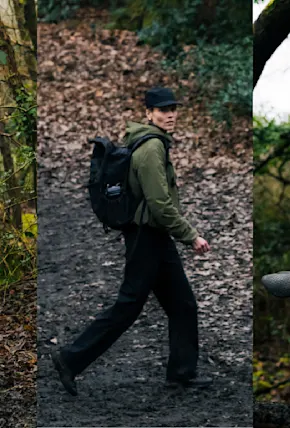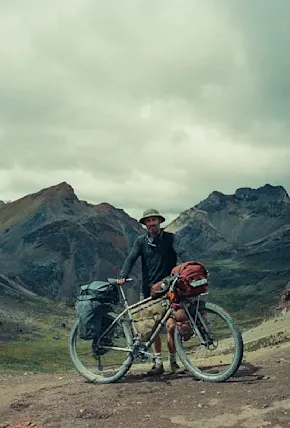Somewhere between the endurance of spandex-clad road cycling, the technicality of mountain biking, and the randonée spirit of trail running lies gravel cycling. The once burgeoning category is now a full-fledged discipline of riding in its own right, and it’s easy to see why. On a gravel bike, you can go further than on a mountain bike and places a road bike simply cannot. Flowy singletrack? Sure. Hammering down freshly paved blacktop? Feels great on huge tires, even if a bit slower than on a peloton-ready steed. Dipping onto a fire road that you have no idea where it goes? That’s what it’s all about.
Cycling is an aesthetically driven sport, and gravel riding is no different. While perhaps less rigid in its sartorial code than its tarmac-bound counterparts, gravel riding has a few unwritten rules to getting kitted that even the gravel curious will want to take note of. Functionality, versatility, and durability are priorities when riding gravel. On a typical ride in Vancouver, I go from warming up on road laps in Stanley Park to braving the elements high in the backwoods single track in Mount Seymour back to the city for a post-ride espresso. So yes—looking good is part of the equation. In this article we will highlight a handful of gravel gear selects and drop some style know-how, too.
But first, a quick caveat. If you’re on a bike, having fun, and being nice to the environment and those around you, you’re good to go—wear whatever you like. Being a jerk and rocking the flyest gear? Not cool. Being kind on the bike is always top priority. Style second. That said, let’s get into it.

Products tested in and out of the saddle
The following gear has been rigorously tested over six months of riding in and around Vancouver, BC. In my testing I logged over 4,000 km on urban trails and forest roads, over mountain passes, and on single track, in sun, rain, and most recently, a snow flurry or two. As a lifelong cyclist—including a decade spent riding in New York City—I know both what to look for and what to look out for. In other words, this list of gravel grinding gear is fully vetted, tested, and approved.
7 Best Gravel Cycling Shoes, Kit and Accessories

Pas Normal Cyling Apparel
Best Gravel Cycling Kit: Pas Normal Studios Escapism Collection
Cycling apparel of all kinds—road, gravel, mountain, commuting—have gotten undeniably cooler and simply better in recent years. From fit to materials to styling, cycling apparel is having a moment and perhaps no brand encapsulates this confluence of design, aesthetics, and culture quite as well as Copenhagen’s Pas Normal Studios. Co-founded by fashion and streetwear OG Karl-Oskar Olsen (of Danish label Wood Wood) PNS has recently collaborated with the likes of Salomon, Porter Yoshida, and Pirelli, and with the gravel-specific Escapism collection has become our go-to kit maker.
With more durable fabrics, forgiving fits, and earth toned colorways, it’s the sort of apparel that flows seamlessly within any GORP-devotees wardrobe alongside and wander, Gramicci, and Snow Peak. After eating plenty of singletrack in the Escapism bibs, I can confirm they show little to no signs of wear. And with two cargo pockets and two stash pockets in the rear, they hold enough food and layers for a full day in the backcountry. Again, speaking from experience.
While Pas Normal Studios is producing innovative apparel to perform at the highest levels of gravel and road riding, it’s the pieces that appear less technical where Olsen’s design chops really show. The Escapism collection features a short-sleeve and long-sleeve technical shirt, each masterfully capturing the style and spirit of gravel. Breathable and flowy yet durable and protective, the wool-blend tees feature strategically placed panels of nylon for increased durability and resistance from the elements. Two side zippers offer easy ventilation and improved access to bib pockets. What’s remarkable about the tech tees is the cut and placement of the seams. Even bombing down West Vancouver’s famous Cypress Bowl Road overlooking city and Howe Sound at over 70 kilometers per hour I experienced no flap and no pull as one might when riding in a loose jersey or normal tech tee. Similar to Quoc, the level of quality of every piece of Pas Normal Studios gear approaches luxury—albeit a level that yearns for dirt.
Pro Tip #1: Rocking a technical tee with bibs is yet another gravel style nuance to embrace. While close-fitting jerseys are also welcome (and come in handy if you really need the pocket space) it’s the bibs and tee combo that’s uniquely a hallmark of gravel riding. Look good, ride good!

Quoc Cycling Shoes
Best Gravel Cycling Shoe: Quoc Gran Tourer XC
Every pedal stroke can be bliss or misery if your shoes aren’t dialed, and with gravel riding there’s a good chance you’ll be doing some hike-a-bike over especially spicy sections and the odd creek crossing, so footwear really counts in this category. As such, shoes with SPD or two-bolt cleat mountain-bike style shoes are best for gravel riding. Easier to clip in and out of, better for walking and hiking, and more comfortable in general.
The Quoc Gran Tourer XC is our pick, especially in the striking Dusty Pink colorway. Part of a burgeoning cottage industry of independent cycling shoe brands, the London, UK-based brand makes aesthetically driven, functional designs actually informed by life on the bike. The Gran Tourer XC is a show-stopper of a gravel shoe, with an unmatched level of craftsmanship that’s apparent from the stitching to the material to the attention to detail in the packaging and included insole accessories.
Quoc uses a proprietary dial system—rather than the industry standard BOA—for a fine-tuned fit that’s comfortable on long rides and easy to batten down for a sprint. And a toe cap featuring contrast rubber construction for improved durability. After hiking over too many boulder sections and “looked okay on the map” trails, they manage to still look fresh. Best of all, the front cleats are replaceable, so you’ll be able to tackle rough sections of trail and long walks of shame for seasons to come.

FINGERSCROSSED Socks
Best Gravel Cycling Socks: FINGERSCROSSED Merino Socks
One can’t address shoes without considering socks, and cycling socks are a hot button issue. Socks must be worn. This isn’t a triathlon. And they must be seen. Again, not a triathlon. Sock length should be in the neighborhood of six to eight inches above the ankle and cycling or performance socks should always be worn (for functional and aesthetic purposes—sorry but rocking your cooked cotton dress socks really isn’t it). Color and coordination is a matter of preference, so we say do what you feel: be it monochromatic shoe-sock-synergy or high-contrast pops.
For high quality and considered design, Germany’s FINGERSCROSSED is leading the pack. Beloved for their sleek, paperweight road socks, the brand takes the same detail-driven approach to gravel riding. The made in Portugal Light Merino Silk socks feature a merino, silk and polyamide blend for temperature regulation, moisture-wicking, and all-day comfort. Improved ventilated around the instep means your feet won’t overheat on those spicy 24% fire road climbs. Available in a wide range of solid colors, our choice is the vibey hand-dyed Batik colorway.











